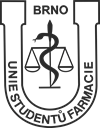STUDENTSKÁ VĚDECKÁ KONFERENCE
MAGISTERŠTÍ STUDENTI
25. 4. 2023
9:00 - 14:15, Pavilon farmacie I
Program sekce farmaceutické technologie, sociální a klinické farmacie
Pavilon farmacie I
-
9:00 - 9:05
Zahájení konference
-
9:05 - 9:15
Prezentace sponzora konference: VIRA CHEMimp
-
10:15 - 11:45
Biologická a chemická sekce
-
11:45 - 12:00
Přestávka
-
12:00 - 12:15
Methods of Incorporation of Detection Reagents for Phosgene Detection into Nanocomposite Pellets
Viktória Kučerová 1, Jiří Zeman 1, Gabriela Mecová 1, Sylvie Pavloková 1, David Vetchý 1, Lukáš Matějovský 2
1 Department of Pharmaceutical Technology, Faculty of Pharmacy, Masaryk University
2 Oritest spol. s r.o., Prague, Czech Republice-mail: 507397@muni.cz
Key words: detection, detection tube, lyophilization, pellets, phosgene
Introduction: Chemical warfare agents (CWAs) are fast-acting and lethal substances, even at low concentrations. They still pose a serious threat in some parts of the world. Rapid detection and identification are important parts of safety precautions. Detection by detection tubes (DTs), which can contain carriers in form of pellets, is based on the formation of colored products, which are usually evaluated visually.
Methods: This study aimed to prepare pellets containing silica nanoparticles and other substances with high specific surface area using the spheronization‑extrusion technique and to verify the possibility of incorporating detection reagents (DRs) into pellets. Samples were dried in a hot air oven or lyophilized, and their physico-mechanical properties were evaluated. Selected samples were tested for diphosgene by Oritest s.r.o. The behavior of the samples in the presence of acetyl chloride, which is a simulant of phosgene, was also investigated.
Results: Samples containing Neusilin® US2 had higher hardness, but samples containing FujiSil® had higher interparticular porosity. Open pores on the surface increased the specific surface area and enabled better adsorption of DRs and CWAs. Lyophilization resulted in a decrease in the number of closed pores and an increased number of open pores. The incorporation of DRs from an ethanol solution during wetting reduced pellet hardness. The physico-mechanical properties of all batches met the requirements for filling into DTs.
Conclusion: During the detection of diphosgene, the pellets did not reach sufficient sensitivity. When tested with an acetyl chloride solution in acetone at a concentration of 1100 ng/ml, the tests were positive; however, at a concentration of 5.5 ng/ml, the pellets did not reach sufficient sensitivity. The used DRs or the methods of their incorporation are considered inappropriate. To improve their sensitivity, it would be advisable to increase the basicity of carriers, increase the amount of DRs, or use different DRs.
Supervisor: PharmDr. Jiří Zeman, Ph.D.
-
12:15 - 12:30
Preparation and Evaluation of Porous Microparticles for Phosgene Detection
Marcela Tkáčová 1, Jiří Zeman 1, Sylvie Pavloková 1, Jakub Vysloužil 1, Lukáš Matějovský 2
1 Department of Pharmaceutical Technology, Faculty of Pharmacy, Masaryk University
2 Oritest spol. s r.o., Prague, Czech Republice-mail: 509160(@)muni.cz
Key words: acetyl chloride, detection, microparticles, phosgene, PLGA
Introduction: Phosgene is a chemical warfare agent but also an important reagent used in the chemical industry. In the case of an industrial accident or when misused by terrorists, many people may be poisoned by this suffocating gas; therefore, rapid detection of its presence is important, for which easy-to-use detection tubes are suitable. This research is focused on porous carriers with high specific surface area, which could adsorb larger amounts of detection reagents and analytes, thus leading to higher sensitivity of the final detection tube.
Methods: This work dealt with the preparation of porous microparticles from poly(lactic-co-glycolic) acid by double emulsion solvent evaporation method with or without using a pore-forming agent. Different batches of microparticles were initially prepared and tested to optimize the preparation process, which aimed to increase the porosity and basicity of microparticles for better color reaction. The prepared batches of microparticles were impregnated with detection reagents 4-(p-nitrobenzyl)pyridine and N-phenyl-benzylamine. Samples were tested with acetyl chloride as a phosgene simulant, which was manifested by the coloring of microparticles. The obtained data from the detection were statistically analyzed using ANOVA. Selected samples were sent to Oritest spol. s r.o. and tested for the presence of diphosgene.
Results: Porous microparticles were successfully prepared using a pore-forming agent. Their further modifications successfully increased the microparticles' porosity but, unfortunately, deformed their structure and agglutinated them together. These modifications had a statistically significant effect (p < 0,05) on the coloration of microparticles.
Conclusion: All microparticles detected the presence of acetyl chloride, and all selected samples detected the presence of diphosgene. However, their sensitivity was not better than that of commercially available detection tube DT-12.
Supervisor: PharmDr. Jiří Zeman, Ph.D.
-
12:30 - 12:45
The Particulate Systems Containing Lipophilic Drugs of Natural Origin for Veterinary Applications
Daniela Hlavatá 1, Jan Muselík 1, Jan Macků 1
1 Department of Pharmaceutical Technology, Faculty of Pharmacy, Masaryk University,
e-mail: hlavatad(@)pharm.muni.cz
Key words: thymol, pellets, rabbit, dissolution, stability
Digestive disorders and diseases are common in rabbit livestock and have high negative economic impacts. In the context of local treatment of intestinal mucosa in rabbits, thymol, an anti-inflammatory agent, was formulated into the pellets and coated with a gastro-resistant polymer. To maintain a controlled release of drug dosage form, it is essential to optimize the processes that maintain such characteristics, which are conventionally verified by a dissolution test. These data provide information on the amount of drug released from the dosage form in the specific medium at the specific time, simulating in-vivo conditions. Multiple batches were tested for the dissolution behavior of different coatings. The best formulation was selected for long-term stability and accelerated stability testing, yet also incorporated into feed granules and tablets.
Pellet batches consisting of thymol (dissolved in the self-emulsifying system), Neusilin®, chitosan and microcrystalline cellulose were prepared and coated with Eudragit® L30 D55 to the wt. 50 % of meeting the pharmacopoeial limits for release of less than 10% of thymol released within the first 2 h. Stability study was performed to evaluate pellets with optimized coating layer thickness and its composition. The pharmacopoeial limit was exceeded after three months at storage conditions of 40 °C, 75 % RH, and therefore accelerated stability was terminated. At 25 °C, 60 % RH, the sample was stable for 6 months. Based on the results, a storage period of 6 months at 25 °C was suggested.
The evaluation of different strategies for incorporating pellets into feed, granulate (crushed rabbit feed with thymol pellets) and tablets (compressed granulate), was tested to evaluate whether the preparation process did cause any damage to the pellets. The tablets and granulate met the pharmacopoeial limit and released less than 10% of thymol within 2 h in pH 1.2. Granulate was judged superior due to the simple feasibility of larger volume production.
We believe that the properly designed drug dosage form might be a promising strategy to highlight thymol potential in the local treatment of the intestines.
Supervisor: doc. Mgr. Jan Muselík, Ph.D.; Mgr. Jan Macků
-
12:45 - 13:00
The COVID-19 Pandemic Impact on Hospital Pharmacies in the Czech Republic
Havlíková Lucia 1
1 Department of Applied Pharmacy, Faculty of Pharmacy, Masaryk University,
e-mail: lucia.havlikova3(@)gmail.com
Key words: pandemic, COVID-19, hospital pharmacies, questionnaire survey, SARS-CoV-2, protective equipment
Background and Aims
The COVID-19 pandemic brought many changes and new requirements with it that individual hospital pharmacies and their employees had to deal with such as the use of personal protective equipment, personnel changes, or assistance with vaccination against the disease COVID-19. The thesis aimed to find out what technical changes, personnel changes, and changes related to completely new requirements hospital pharmacies were forced to adopt resulting from the COVID-19 pandemic in two years, from March 2020 to May 2022, and to evaluate their extent.Methods
A questionnaire survey was conducted, which addressed all hospital pharmacies in the Czech Republic, using the GoogleForms web interface. The survey took place over a period of two months, from 9.6. 2022 until 31.7.2022. The questionnaire contained a total of 34 questions, of which 27 were closed-type, and 7 were open-type. The individual questions were divided into four thematic areas (demography of the medical facility, specific changes in the technical requirements of the pharmacy, personnel changes in the pharmacy, new requirements for hospital pharmacies during the COVID-19 pandemic, and new activities in which individual pharmacies participated as a result of the pandemic).Results
Fifty-four completely completed questionnaires were included in the final evaluation (50% return rate). The largest significant increase was recorded in the use of personal protective equipment, respirators (99%); on the other hand, the lowest significant increase was recorded in the use of air ionizers (1%). Most of the listed technical parameters were not used by pharmacies at all before the pandemic. The exception is surface disinfectants, which were used by 88% of pharmacies even before the pandemic. 76% of pharmacies participated in the individual preparation of disinfection, while the majority prepared disinfection for personal purposes (90%). In most pharmacies, there were no changes to the opening hours, and the pharmacy's operating hours remained unchanged even during the pandemic (83%). Almost half of hospital pharmacies (46%) experienced restrictions on the operation of the pharmacy due to reasons such as quarantine or a positive result of a test for the disease COVID-19. Almost all hospital pharmacies experienced an increase in questions from patients regarding testing for COVID-19; the most frequently used form of implementation of these questions was direct communication between the patient and the pharmacist (99%). 96% of hospital pharmacies experienced the problem of unavailability of drugs and medicinal preparations. Most often, they solved this problem by trying to increase the stock of drugs primarily used to treat COVID-19 (93%). 99% of hospital pharmacies participated in new activities that they had to face as a result of the COVID-19 pandemic, such as the distribution of vaccines and assistance with vaccination or the distribution of medicinal preparations for the disease of COVID-19 and related activities.Conclusion
It is clear from the results that the COVID-19 pandemic greatly impacted hospital pharmacies and significantly affected their functioning. Our results show that the hospital pharmacies were able to promptly react to the newly created situation and tried to continue to do everything for safe operation with the least possible impact on limiting the operation of the pharmacy.Author's CV: Lucia Havlíková is a fifth-year student at the Faculty of Pharmacy of Masaryk University
Supervisor: PharmDr. Bc. Dana Mazánková, Ph.D.
-
13:00 - 13:15
Current Trends in Psychopharmacotherapy of First-Episode Schizophrenia
Nicole Šafářová 1, PharmDr. Bc. Hana Kotolová, Ph.D. 1
1 Department of Human Pharmacology and Toxicology, MU
Key words: schizophrenia, first-episode psychosis, antipsychotics, psychopharmacotherapy
Introduction: Schizophrenia is a serious mental illness with a spectrum of complex symptoms. Positive symptoms are mostly dominant in the acute phase of schizophrenia and the main treatment method of these symptoms is the usage of antipsychotics. Nowadays, there is a wide range of effective antipsychotics available on the market, which help to achieve remission in patients with schizophrenia. Adequately chosen medication in the first-episode of psychosis in schizophrenia is essential for patient’s long-term well-being.
Aim: The aim of this thesis was to analyse the antipsychotic medication used in Bohnice Psychiatric Hospital in the therapy of first-episode schizophrenia and to further compare these practices with guidelines of the Czech Psychiatric Society ČLS JEP.
Methods: Data was collected from Bohnice Psychiatric Hospital database. From all patients hospitalized for psychotic disorders in years 2016-2022, a set of 32 patients with a diagnosis of schizophrenia who were treated for first-episode psychosis (FEP) with a maximum age of 40 years was selected. Among these 32 patients there were 17 men and 15 women. Age, sex, physiological functions and antipsychotic medication and its dosage were recorded for each patient.
Results: Average age of patient with FEP in schizophrenia were 26,35 years for men and 29,33 years for women. Of the total number (N=32) of patients, olanzapine (53,1 %) and risperidone (34,4 %) were the most common first choice medications. Initial recommended dosage of olanzapine (10 mg/day) and risperidone (2mg/day) was followed in 70,6 % (N=17) and 81,8 % (N=11) cases respectively. Risperidone was chosen as a first choice medication in 47,1 % (N=17) men and 20 % (N=15) women. Olanzapine on the other hand was prescribed as a first choice medication in 73,3 % (N=15) women and 35,3 % (N=17) men. In 41 % (N=22) cases, olanzapine was dosed off-label. LAI/depot antipsychotics were used only in 15,6 % (N=32) cases. 56,3 % (N=32) of patients were released from hospital on antipsychotic combination therapy. Most commonly used combinations were observed between multi-acting receptor-targeted antipsychotics (MARTA) and dopamine receptor partial antagonists (DRPAs) in women - 87,5 % (W, N=8) vs. 30 % (M, N=10) and between MARTA and haloperidol in men - 60 % (M, N=10) vs. 37,5 % (W, N=8)
Conclusions: Olanzapine was overall the most effective antipsychotic medication for stabilizing FEP in schizophrenia (62,4 %, N=32) in patients hospitalized in Bohnice Psychiatric Hospital. As a first choice medication, risperidone was more frequently prescribed in men and olanzapine in women. In majority of cases, the Czech Psychiatric Society ČLS JEP guidelines for treatment of acute phase of schizophrenia and the recommended dosage by manufacturer for each antipsychotic were followed. The main difference between the clinical practice and Czech Psychiatric Society ČLS JEP guidelines was the approach to polypharmacy.
Author’s CV: Nicole Šafářová is a fifth-year student of the Master’s degree programme at the Faculty of Pharmacy of Masaryk University
Supervisor: PharmDr. Bc. Hana Kotolová, Ph.D.
-
13:15 - 14:00
Zasedání odborných hodnoticích komisí
-
14:00 - 14:15
Vyhlášení výsledků
-
od 14:15
Raut






